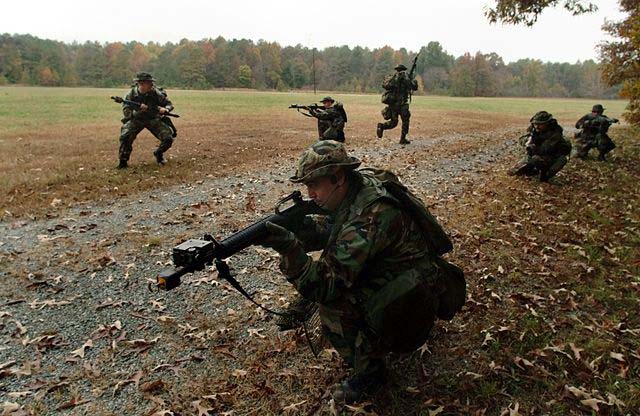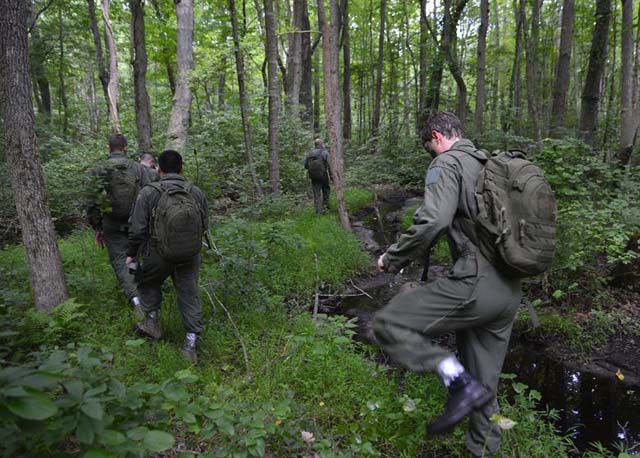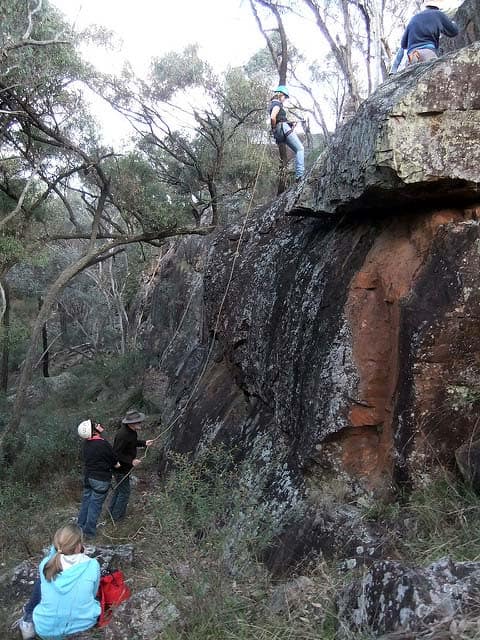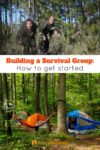The prepper community idolizes the lone wolf- the survivor who goes out alone after a disaster.
But the truth is that we humans have our strength in numbers. If you want to truly be prepared for disaster, you need to build a survival group.
The Ideal Survival Group
Ideally, your survival team would consist of 4-7 adults who are:
- Physically fit – more on prepper fitness
- Mentally tough
- Able to contribute a valuable survival skill, such as hunting or building shelters.
In the real world, though, it is unlikely that you will be able to build such a team. Good luck finding a group of people without family members they’d like to take along (whom will likely be weak links, such as children).
It might not seem hard to find at least 3 people to fit this bill and build a survival team – but even finding 3 people is a lot harder than you’d think!
Start with Your Family
Rather than trying to set up a group from scratch, start with the people you can already rely on – your family.
It is easier to train your family members in survival skills than try to find all of these skills in strangers – not to mention build up the trust of such strangers.
Another reason to use your family as your survival team is that you won’t have to worry about grouping with team members who may live far away from you.
Hopefully, you already have an emergency communication plan so your family can quickly gather and take action.
There are a lot of ways that you can get your family prepared for survival. These include:
Bug-In or Bug-Out Survival Team?

In the aftermath of a disaster, you’ll have to decide whether to bug in (aka hunker down) or bug out.
You don’t necessarily want the same group for both situations. Each type of team requires a different skill set and mentality.
Bug-In
Most preppers I’ve talked to don’t bother with a bug-in survival team. They believe it is better to just stockpile their supplies and hope for the best.
But what if your home ends up being the epicenter of disaster? Wouldn’t it be wise to have an alternate bug-in location (the home of one of your survival team members) to go to?
Likewise, what if looters attack your home? Wouldn’t you prefer a survival team to help you defend your supplies – even if it means having to share those supplies with the team member?
A Bug-In Survival Team Should Be:
- Smaller group: This depends on the size of your location. You won’t want too many people because your supplies will run out faster. But you do want enough people that you can defend your location.
- Live close by: You don’t want anyone to go long distances to reach the bug-in location.
- Be willing to invest in supplies: Since you won’t be able to obtain new resources once you’ve hunkered down, you need an ample stockpile. Depending on your plan, each team member might contribute supplies to one central stockpile or create a stockpile at their homes. It is better for each home to have its own stockpile, but this option is costlier.
- Know about ammunition and home defense: The most significant threat when bugging in is that looters will come for your supplies. A group with knowledge of home defense can prevent this from happening.
Bug-Out

One of the first steps in prepping is to choose a bug out location and plan how to reach it. If you are a lone prepper, it may make sense to form a team. When SHTF, you will get in contact and head to the bug out location together.
The bug out team needs to be:
- No more than 4-5 people: Ever tried hiking with a large group? It takes a heck of a lot longer because not everyone can keep the same pace. Plus, it is a lot harder to remain stealthy when trekking with a lot of people.
- Physically fit and ready to run while carrying a heavy bug out bag, if necessary.
- Knowledgeable of wilderness survival: This is not the time for someone to get bit by a snake or wipe their butt with poison ivy because they have no experience in the wild!
How are 4 to 5 people supposed to survive a long-term disaster?
Your bug-out team – the ones you head out with – should be small. However, it is smart for several small teams to plan to meet up at the bug out location.
Survival Community Team
In contrast to the bug out team, the survival community can be large. These are the people you will meet up with at the bug out location.
Ideally, you’ll have enough people to form a self-sustaining community. Of course, this depends on the land you have chosen for your bug out location.
We’ve discussed how much land is needed to be self-sufficient. It can vary from 42 square meters for a family of four to 17 acres per person. Again, this depends a lot on the land, how you use it, and your level of knowledge.
Choosing Members for Your Survival Community
Ideally, each member of your survival community should have a skill to contribute. This doesn’t mean kids and other “non-skilled” members should be prohibited from joining. They can contribute by doing non-skilled tasks like cleaning up and weeding the garden.
However, you should ensure that you have at least one team member to fill each of the following survival tasks. I say at least one member because it is possible that one team member won’t make it to the location.
What would you do, for example, if the only person with medical skills doesn’t arrive???
Must-Have Skills Your Survival Team Members Should Fill:
- Agriculture: Look for people who know skills like gardening, hydroponics, and aquaponics
- Hunting: Avoid recreational hunters. You need hunters who can gut and clean their kill.
- Raising animals for food: Look for people who have the full spectrum of skills related to this, such as animal husbandry and veterinarian skills
- Foraging
- Medicine: This includes doctors, nurses, paramedics, EMTs, and first aiders.
- Mechanics and engineering: For when things break, or you need to devise tools, such as water pumps or solar energy systems
- Defense/security: Military and military veterans are great for this
- Mental toughness
- Ability to work together
Make sure that each member of the group knows what their responsibilities will be. Have these discussions BEFORE disaster strikes!
Mental Toughness and Ability to Work Together
Of all the survival skills, the last two are probably the most important.
As for mental toughness, you need resilient team members in the face of disaster. The last thing you want is to waste precious time/energy calming down team members having a panic attack!
Likewise, you need team members who can work together (hence the word team!). Even in non-stressful situations, it is easy for fights to break out.
In a disaster, stress and uncertainty can cause lots of problems.
That is why you need to put your team members to the test. More on this below.
Assigning a Leader
Many articles about building a survival team talk about assigning a leader.
Having an assigned leader is a good idea – but you also must set up guidelines about how decisions will be made.
You don’t want other team members to get angry if they think the leader is making bad decisions or overstepping boundaries.
Putting These Skills to the Test

Once you’ve found some members of your survival team, you need to put the team to the test. The goal is to see how the team will work together or whether fights will break out.
This doesn’t necessarily mean doing disaster simulations and drills (though that is a good idea).
Here are some team-building exercises you can do to see whether your group will be able to get along:
- Go to an escape room
- Go camping
- Take a survival course together
- Have a paintball competition
- Go rafting
- Go on a jeep treasure hunt
- Do an obstacle course
- Go rock climbing or abseiling
- Play capture the flag
- Play football
- Take a wilderness first aid course together
Don’t be surprised when a team member’s real personality starts to show through!
After doing a few of these activities, you might no longer want a particular person to be on your survival team.
Do you have a survival group? How many members are in it, and how did you find them? Let us know in the comments below.
Training to survive, U.S. Air Force photo/Capt. Bernie Kale
Team dover airmen, U.S. Air Force photo/Airman 1st Class William Johnson



There’s 1 thing I’ve never seen mentioned re. the lone wolf (& spouse if married) vs group where food will vanish very rapidly compared to that lone wolf ( & spouse?) whove decided best to stay put where weather nasties did not apply. The food for 1 or possbly 2 will last so much longer than when necessary to share with a group !
As a “weak link” because of reduced mobility in my case, how do you go about finding a group?
I do have a couple of useful skills (from woodworking and homebuilding low tech solutions for heating and water gathering to plant knowledge, outdoor cooking, building shelters, natural navigation and first aid) and I’m an OK teacher, but people will most likely get hung up on my disability: for many “modern performance preppers” a person with an above knee amputation is a huge no-no!
Ah well… some may find out after SHTF that I can still be of some use ha ha. (That is, of course, if I survive the event.) A little broken, but still good.
In the meantime I will continue puttering around, tortoise style, working to acquire a few practical gardening skills too.
There were approximately 10,000,000 Indians in the lower 48 states when the white man arrived. They existed in a hunter gatherer economy.
My Point:
That is approximately how many can be existed to exist in a hunter gatherer economy should America collapse.
You will need food from another source.
Extra,
For much of the Great Plains a 160 acre homestead could provide enough for most to survive. Getting into the 1900s, in marginal lands, they were offering up to 640s and that was not enough.
Yeah but how do I go out and find these people I have a whole design setup with various bug out locations in case of the worst with an emergency one incase the main one goes south I have one or two people but no one who actually preps but in England it’s hard to find groups of actual preppers or preppers in general so is there any advice you can provide for that
Think outside of the box. There are a lot of “preppers” who don’t actually identify as preppers. For example, you could join a local canning group, gardening group, foraging group, take a first aid course…
When you talk about Mechanics and engineering, what kind of people would be suitable? Not engineers that work on CAD software no doubt, but more simply maintenance people and machine workers?
Well, one of my best friends is a welding engineer and has a complete welding shop setup, materials, etc. He is definitely valuable to have around! And, actually, knowing CAD software might not be useless. That knowledge could be applied to create/plan various off-grid structures and systems. We all have *something* we can contribute if we just think outside of the box a bit. 🙂